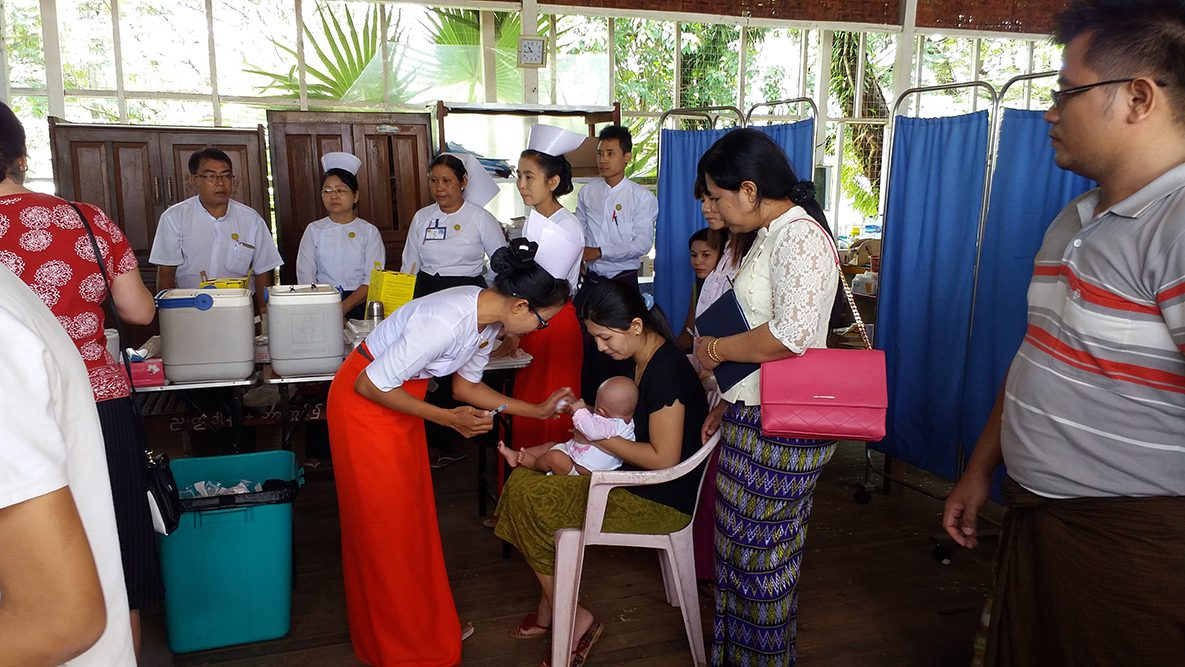Prevent avoidable epidemics, including naturally occurring, accidental, or intentional outbreaks.

Baby receiving pentavalent vaccine in Myanmar.
Action Package Results—CDC-Supported achievements in 17 Priority Countries
- 6 Countries
- 1.65 Billion Total Population
Results: Countries with designated laboratory facilities that conducted antimicrobial susceptibility tests (AST) and reported to the designated national body in the last 6 months.
Why it matters: Antimicrobial-resistant (AMR) organisms have adapted to widespread use of antibiotics, decreasing our ability to treat diseases. Identifying AMR organisms allows us to react quickly when they spread.
- 6 Countries
- 1.86 Billion Total Population
Results: Countries where surveillance data are shared between human and relevant animal health sectors for all prioritized zoonotic diseases.
Why it Matters: An estimated 6 out of 10 infectious diseases are zoonotic and spread between animals and humans. We quickly need to know about zoonotic disease outbreaks in animals to prepare for and prevent possible spread into human populations
- 4 Countries
- 1.32 Billion Total Population
Results: Countries where all national laboratories have physical security controls and electronic inventories for all dangerous pathogens and toxins.
Why it Matters: Dangerous pathogens need to be handled carefully and stored securely to prevent them from accidentally or intentionally being released and harming the public.
- 11 Countries
- 2.0 Billion Total Population
Results: Countries that have improved community immunization coverage based on surveillance of disease burden.
Why it Matters: Effective immunization systems reduce illness and death from vaccine-preventable diseases, and help limit the magnitude and number of infectious disease outbreaks.
- Reduce factors that contribute to antimicrobial resistance
- Reduce factors that contribute to the spread of zoonotic diseases in humans
- Promote safe and secure ways to manage biological materials to keep laboratory workers safe and reduce the risk of theft, loss, or mishandling of dangerous pathogens that could harm the public
- Strengthen the prevention, detection, and response to zoonotic diseases through One Health Zoonotic Disease Prioritization workshops and the development of national action plans to combat the exchange of disease between animals and humans
- Establish and strengthen vaccination programs to protect people from highly contagious yet preventable diseases and conduct vaccination outbreak response measures
What Remains to Be Done?
Zoonotic disease collaboration has seen significant progress. All 17 GHSA Phase I countries have engaged in a multisectoral, One Health collaboration using CDC’s One Health Zoonotic Disease Prioritization process. However, the capacity to share data between human, animal, and/or environmental health sectors remains challenging in 11 of 17 GHSA Phase I countries.
These challenges can leave countries vulnerable, as relevant sectors encounter barriers to acting collaboratively to prevent, detect, or respond to zoonotic diseases (e.g., rabies, influenza viruses, hemorrhagic fevers, and anthrax). To address these gaps, CDC is working with countries to strengthen critical public health infrastructure by training physicians, veterinarians, and others to better identify and detect zoonotic diseases and share information for faster action.